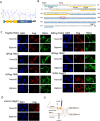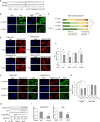Thioredoxin-related transmembrane protein 2 (TMX2) regulates the Ran protein gradient and importin-β-dependent nuclear cargo transport
- PMID: 31653923
- PMCID: PMC6814788
- DOI: 10.1038/s41598-019-51773-x
Thioredoxin-related transmembrane protein 2 (TMX2) regulates the Ran protein gradient and importin-β-dependent nuclear cargo transport
Abstract
TMX2 is a thioredoxin family protein, but its functions have not been clarified. To elucidate the function of TMX2, we explored TMX2-interacting proteins by LC-MS. As a result, importin-β, Ran GTPase (Ran), RanGAP, and RanBP2 were identified. Importin-β is an adaptor protein which imports cargoes from cytosol to the nucleus, and is exported into the cytosol by interaction with RanGTP. At the cytoplasmic nuclear pore, RanGAP and RanBP2 facilitate hydrolysis of RanGTP to RanGDP and the disassembly of the Ran-importin-β complex, which allows the recycling of importin-β and reentry of Ran into the nucleus. Despite its interaction of TMX2 with importin-β, we showed that TMX2 is not a transport cargo. We found that TMX2 localizes in the outer nuclear membrane with its N-terminus and C-terminus facing the cytoplasm, where it co-localizes with importin-β and Ran. Ran is predominantly distributed in the nucleus, but TMX2 knockdown disrupted the nucleocytoplasmic Ran gradient, and the cysteine 112 residue of Ran was important in its regulation by TMX2. In addition, knockdown of TMX2 suppressed importin-β-mediated transport of protein. These results suggest that TMX2 works as a regulator of protein nuclear transport, and that TMX2 facilitates the nucleocytoplasmic Ran cycle by interaction with nuclear pore proteins.
Conflict of interest statement
The authors declare no competing interests.
Figures






Similar articles
-
Ran-dependent docking of importin-beta to RanBP2/Nup358 filaments is essential for protein import and cell viability.J Cell Biol. 2011 Aug 22;194(4):597-612. doi: 10.1083/jcb.201102018. J Cell Biol. 2011. PMID: 21859863 Free PMC article.
-
Identification of different roles for RanGDP and RanGTP in nuclear protein import.EMBO J. 1996 Oct 15;15(20):5584-94. EMBO J. 1996. PMID: 8896452 Free PMC article.
-
Influence of cargo size on Ran and energy requirements for nuclear protein import.J Cell Biol. 2002 Oct 14;159(1):55-67. doi: 10.1083/jcb.200204163. Epub 2002 Oct 7. J Cell Biol. 2002. PMID: 12370244 Free PMC article.
-
On the asymmetric partitioning of nucleocytoplasmic transport - recent insights and open questions.J Cell Sci. 2021 Apr 1;134(7):jcs240382. doi: 10.1242/jcs.240382. Epub 2021 Apr 13. J Cell Sci. 2021. PMID: 33912945 Review.
-
Nucleocytoplasmic protein transport and recycling of Ran.Cell Struct Funct. 1999 Dec;24(6):425-33. doi: 10.1247/csf.24.425. Cell Struct Funct. 1999. PMID: 10698256 Review.
Cited by
-
TMX5/TXNDC15, a natural trapping mutant of the PDI family is a client of the proteostatic factor ERp44.Life Sci Alliance. 2024 Sep 30;7(12):e202403047. doi: 10.26508/lsa.202403047. Print 2024 Dec. Life Sci Alliance. 2024. PMID: 39348940 Free PMC article.
-
Thioredoxin-Related Transmembrane Proteins: TMX1 and Little Brothers TMX2, TMX3, TMX4 and TMX5.Cells. 2020 Aug 31;9(9):2000. doi: 10.3390/cells9092000. Cells. 2020. PMID: 32878123 Free PMC article. Review.
-
Introducing Thioredoxin-Related Transmembrane Proteins: Emerging Roles of Human TMX and Clinical Implications.Antioxid Redox Signal. 2022 May;36(13-15):984-1000. doi: 10.1089/ars.2021.0187. Epub 2021 Dec 7. Antioxid Redox Signal. 2022. PMID: 34465218 Free PMC article. Review.
-
TMP- SSurface2: A Novel Deep Learning-Based Surface Accessibility Predictor for Transmembrane Protein Sequence.Front Genet. 2021 Mar 15;12:656140. doi: 10.3389/fgene.2021.656140. eCollection 2021. Front Genet. 2021. PMID: 33790952 Free PMC article.
-
TMX2 potentiates cell viability of hepatocellular carcinoma by promoting autophagy and mitophagy.Autophagy. 2024 Oct;20(10):2146-2163. doi: 10.1080/15548627.2024.2358732. Epub 2024 Jun 10. Autophagy. 2024. PMID: 38797513
References
Publication types
MeSH terms
Substances
LinkOut - more resources
Full Text Sources
Molecular Biology Databases
Research Materials
Miscellaneous

